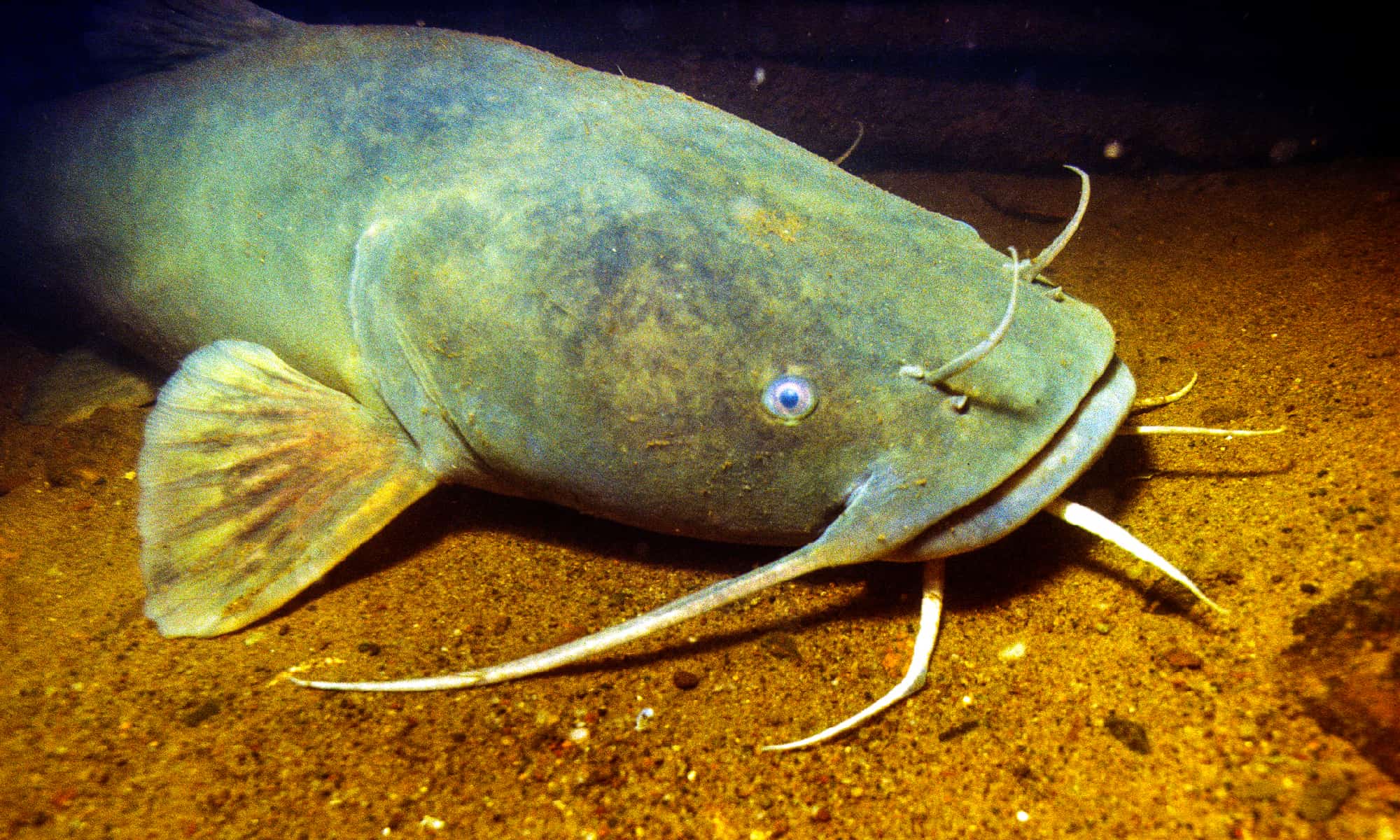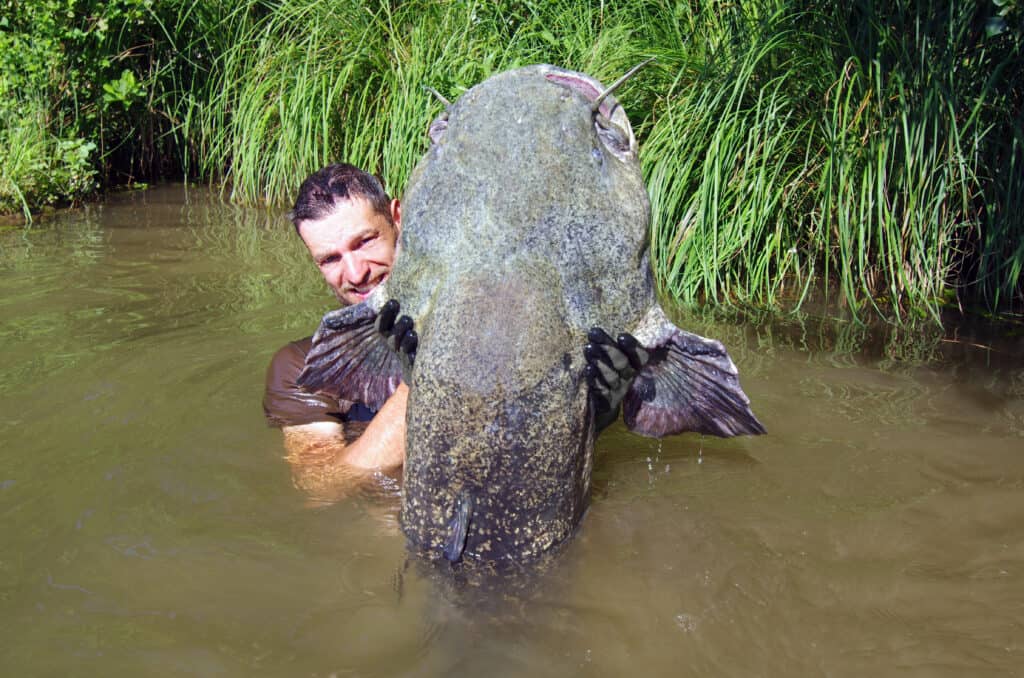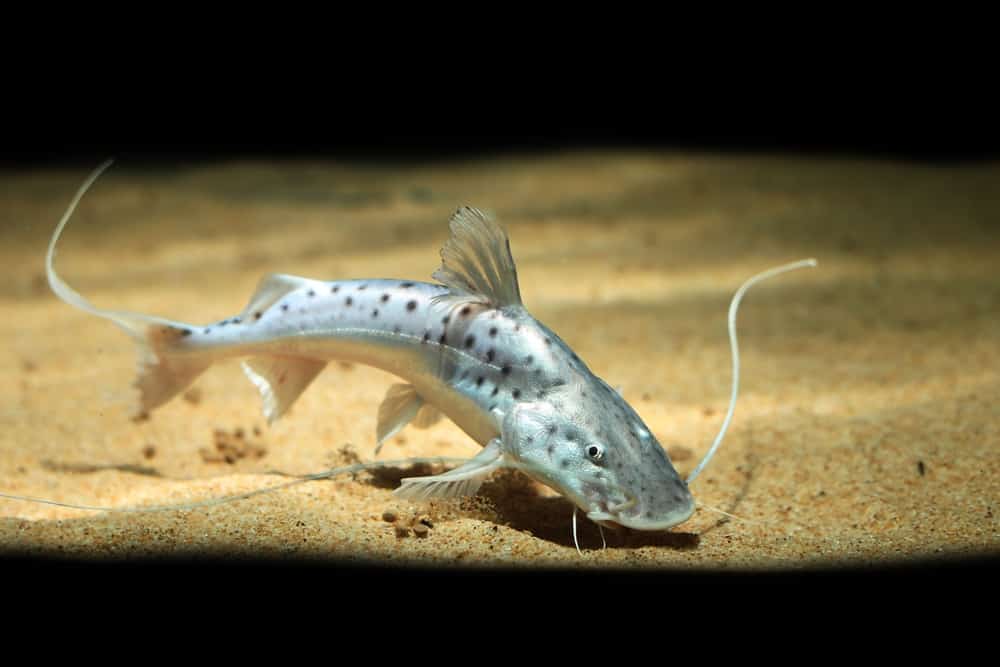There are nearly 3,000 different species!
Advertisement
Catfish Scientific Classification
- Kingdom
- Animalia
- Phylum
- Chordata
- Order
- Siluriformes
- Scientific Name
- Siluriformes
Read our Complete Guide to Classification of Animals.
Catfish Conservation Status
Catfish Facts
- Main Prey
- Fish, Frogs, Worms
- Distinctive Feature
- Flat, broad head and whiskers
- Optimum pH Level
- 6.5 - 8.0
- Habitat
- Fast-flowing rivers and lakes
- Predators
- Large Fish, Birds, Mammals, Reptiles
View all of the Catfish images!
Feeding at the depths of the lake or river, the catfish is always aware of its surroundings thanks to the prominent whiskers on its face and an elaborate network of chemical receptors all over its body.
The amazing sensory apparatus on this species relays important information about the composition of its surrounding environment. The catfish has also served as a common delicacy in many human cultures around the world. This is both a blessing and a curse. Where there is no regulation on fishing, the catfish may be driven to the brink of extinction. But when humans take an interest in its survival, the catfish is allowed to thrive.
An Incredible Fish: Three Catfish Facts!
- The catfish is known by many different local names. In the American South, it is sometimes called a mud cat or chucklehead.
- Introduced by humans into various non-native environments for the purposes of farming, this is one of the top invasive species in the world. It can cause serious damage to the ecosystem by consuming much of the local plants and animals.
- Some species produce a venomous compound to deal with threats. This has proven to be dangerous to humans in only a few rare cases. The venom of the striped eel catfish in particular has resulted in the deaths of a few people.
Want more catfish facts? Check out ‘10 Crazy-Cool Catfish Facts.’
Different Types

This flathead catfish,
Pylodictis olivaris, lying on bottom of Mississippi River, is only one example of possibly 3,000 different species of catfish.
©iStock.com/stammphoto
The order of Siluriformes possesses a truly staggering amount of diversity. It contains around 3,000 species across 35 different families. By comparison, the primate order, which includes all humans, apes, and monkeys, is composed of only a few hundred species. Here are just a few examples of catfish species:
- Blue Catfish: Endemic to Mexico and the Southeastern United States, this is the largest species of catfish on the entire North American continent. With its blue-gray coloration, this fish is highly tolerant of brackish waters, which has allowed it to thrive in all kinds of rivers and lakes.
- Channel Catfish: This species inhabits much of the United States and Mexico east of the Rocky Mountains. It is probably the most fished catfish species in the world. If you’ve ever eaten catfish, then you’ve likely had this type of fish. Its popularity has led to its introduction in Europe, Asia, and South America, where it’s sometimes considered an invasive species.
- Cory Catfish: Cory catfish are popular in the aquarium trade. In the wild, the species buries its snout into river bottoms and vacuums up food. Cory catfish eat an omnivorous diet of fish pellets and other foods like worms when kept in captivity.
- Micro Catfish: This tropical freshwater fish of South America is one of the smallest catfish species in the world. It grows to a length of no more than one or two inches.
- Mekong Giant Catfish: At the other end of the spectrum, the massive Mekong giant catfish is part of the shark catfish family. It inhabits the Mekong basin of Southeast Asia and China.
- Goonch: Also known as the giant devil catfish, the goonch is a large species weighing over 200 pounds. Residing mostly in India, the goonch has inspired both fascination and terror.
Here are even more types of catfish to check out:
- Banjo Catfish, Ghost Catfish, Pictus Catfish, Redtail Catfish, Hardhead Catfish, Armored Catfish, Gulper Catfish, White Catfish, Flathead Catfish, and the Yellow Bullhead Catfish.
Classification and Scientific Name
All catfish belong to a single order known by the scientific name of Siluriformes. As you may already know, an order is the next major level of taxonomy below a class. In the case of the catfish, it is in a class of ray-finned fishes known as the Actinopterygii, which also includes tuna, swordfish, salmon, cod, and many other types of fish. All catfish evolved from a single common ancestor. This means a single group branched out and led to all modern catfish species.
Appearance

The channel catfish is common in the United States and a good example of this order of fish known for its barbels (whiskers or feelers).
©iStock.com/v_zaitsev
This fish comes in a diverse range of colors, shapes, and characteristics, but there are a few distinct traits that unite all species together. The most prominent physical characteristic is the pair of long barbels (the whiskers or feelers) along the upper jaw that act as sensory organs. Most actually have receptors all over the body that allow them to taste or smell various chemicals in the water, but the barbels are the main instruments through which they sense the surrounding environment. A single pair is standard, but some may have up to four pairs of whiskers arranged along the mouth, snout, and chin.
Another important sensory feature is a bony structure that connects the swim bladder to the fish’s auditory system called a Weberian apparatus. This enables it to produce and detect sounds in the water.
Most have a long body and flattened head to allow for bottom feeding. With their tendency to sink rather than float, they spend most of their time sifting the floor for food, usually during the night but sometimes during the day as well. Their mouths are widely spaced to take in large quantities of food at a single time. Most species are gray, white, yellow, brown, or green in color. The skin consists of bony plates or a lining of mucus instead of scales. A spine near the fins is present in some species to ward off dangerous predators. It usually delivers either a sharp sting or a very painful and debilitating venom.

Some species of catfish are enormous in size — much bigger than the average catfish caught for dinner in the United States.
©Fabien Monteil/Shutterstock.com
The size also reflects its immense diversity. The order ranges greatly in size between the banjo catfish, which is less than an inch long, and the truly massive wels catfish, which measures up to 15 feet in length and 660 pounds in weight. Sexual differences between males and females seem to occur in about half of all documented families. Some species feature truly unusual adaptations. For instance, the upside-down catfish lives up to its name by swimming upside down. The electric catfish in Africa can generate some 450 volts of electricity. The walking catfish can traverse land for short distances in between pools by moving on its front fins and tail; it also has the ability to breathe in oxygen from the air. Each of these adaptations is well-suited for the environment in which it lives.
Distribution, Population, and Habitat
The majority of this type of fish inhabit the shallow freshwater regions of every continent on the planet except for Antarctica. The only exceptions are several species adapted specifically for saltwater environments or even caves. Population numbers are generally quite strong across the world, and most species are not yet at risk of extinction. However, some species are increasingly in peril due to overfishing and marine pollution. The Mekong giant catfish of Southeast Asia and China, the Andean catfish of Ecuador, the blind-whiskered catfish of Mexico, and several other species are all considered to be critically endangered, while many others are trending that way.
Predators and Prey

Large Piraiba catfish (Brachyplatystoma filamentosum) seaching for food such as algae, snails, worms, insects, or whatever is local.
©Pavaphon Supanantananont/Shutterstock.com
The catfish lives in so many different places that it has a staggering list of predators. Some of the most common predators include birds of prey, snakes, alligators, otters, fish (including other catfish), and of course, humans. Due to their large physical size and defensive spines, the catfish is hardly the first choice of prey for many predators. But some of the smaller of the species, in particular, are most vulnerable.
This fish’s diet also varies greatly by location. Most species feed on random algae, snails, worms, insects, and other small marine creatures by sucking or gulping them up with their huge mouths. The larger species consume frogs, newts, birds, rodents, and other animals as well. For a complete analysis of what catfish eat, we published ‘What Do Catfish Eat? 13 Foods in Their Diet.‘
Reproduction and Lifespan
With approximately 3,000 species to account for, this fish varies quite a bit in terms of its reproduction habits. Breeding season usually occurs during the late spring and early summer. The females can lay thousands of eggs at a time within small hiding places such as rock crevices or dense vegetation. The eggs hatch quickly after a mere 5 to 10 days. The male is tasked with much of the parental duty. The maximum life expectancy of a typical catfish species is anywhere between 8 and 20 years in the wild. Some of them obviously fall victim to predators long before this.
Fishing and Cooking
The catfish is such a popular dish throughout the world that large numbers of catfish are deliberately raised in farms. Each local culture tends to have its own method of cooking the catfish. In the Southeastern United States, it is typically rolled in cornmeal and fried. In Southeast Asia, it is grilled or fried and then eaten with various vegetables and spices. In Hungary, it is cooked with paprika sauce and noodles.
View all 235 animals that start with CCatfish FAQs (Frequently Asked Questions)
What eats catfish?
The catfish is consumed by birds of prey, large reptiles, mammals, and other fish.
What do catfish eat?
The catfish has an eclectic diet consisting of algae, snails, worms, insects, aquatic plants, small mammals, and much else.
Is catfish good to eat?
The catfish has been an important source of nutrition throughout human history. It is high in Vitamin D and omega-3 fatty acids.
What does catfish taste like?
The catfish has a rather sweet but subtle taste. Some people either love or dislike its watery/moist feeling.
What Kingdom do Catfish belong to?
Catfish belong to the Kingdom Animalia.
What phylum to Catfish belong to?
Catfish belong to the phylum Chordata.
What order do Catfish belong to?
Catfish belong to the order Siluriformes.
What type of covering do Catfish have?
Catfish are covered in Scales.
In what type of habitat do Catfish live?
Catfish live in fast-flowing rivers and lakes.
What are some distinguishing features of Catfish?
Catfish have flat, broad heads and whiskers.
How many eggs do Catfish lay?
Catfish typically lay 40 eggs.
What is an interesting fact about Catfish?
There are nearly 3,000 different species of Catfish!
What is the scientific name for the Catfish?
The scientific name for the Catfish is Siluriformes.
What is the lifespan of a Catfish?
Catfish can live for 8 to 20 years.
What is the optimal pH for a Catfish?
The optimal pH for a Catfish is between 6.5 and 8.0.
How do Catfish have babies?
Catfish lay eggs.
What's the difference between blue catfish and channel catfish?
There are many differences between the blue catfish and the channel catfish. Channel catfish grow much smaller than blue catfish, and blue catfish are pickier eaters.
What's the difference between swai and catfish?
There are many differences between swai and catfish, including their sizes and locations. Swai are larger than some types of catfish and are only found in Asia, while catfish are found around the world.
What's the difference between catfish and bullheads?
The main difference between catfish and bullheads is that bullheads have square tails, while catfish tails are notched. Most catfish also outgrow bullheads in terms of their size and weight.
How to say Catfish in ...
Thank you for reading! Have some feedback for us? Contact the AZ Animals editorial team.
Sources
- Brittanica, Available here: https://www.britannica.com/animal/catfish
- Soft Schools (1970) https://www.softschools.com/facts/animals/catfish_facts/1119/ Jump to top

















